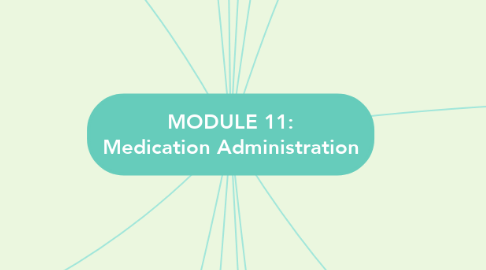
1. Sources of Drugs
1.1. Plants
1.2. Animals
1.3. Minerals & Mineral Products
1.4. Chemical Substances Made in Laboratory
2. Classification of Drugs
2.1. Prescription Drugs
2.1.1. Patient's Information
2.1.2. Date of Prescription
2.1.3. Rx Symbol
2.1.4. Name & Dosage of Medication
2.1.5. Dispensing instructions for the pharmacist
2.1.6. Directions for the Client
2.1.7. Refill and/or specialized labelling instructions
2.2. Nonprescription Drugs
2.3. Investigational Drugs
2.4. Illicit/Street Drugs
3. Effects of Drugs
3.1. Therapeutic
3.2. Side Effect
3.3. Drug Allergy
3.4. Anaphylactic Effect
3.5. Drug Tolerance
3.6. Cumulative
3.7. Idiosyncratic
3.8. Drug Abuse
3.9. Drug Dependence
3.10. Addiction
3.11. Habituation
3.12. Drug Interaction
3.13. Drug Antagonism
3.14. Synergism
3.15. Summation
3.16. Potentiation
4. Medication Order
4.1. Standing Order
4.2. Single Order
4.3. Stat Order
4.4. PRN Order
5. Pharmacokinetic Factors in Drug Therapy
5.1. Absorption
5.2. Distribution
5.3. Metabolism
5.4. Excretion
6. Route of Drug Administration
6.1. Oral
6.2. Sublingual
6.3. Buccal
6.4. Topical
6.4.1. Dermatologic
6.4.2. Otic (ear)
6.4.3. Inhalation
6.4.4. Ophthalmic
6.4.5. Nasal
6.4.6. Vaginal
6.5. Rectal
6.6. Parenteral
6.6.1. Intradermal
6.6.2. Subcutaneous
6.6.3. Intramuscular
6.6.4. Intravenous
6.6.5. Intraarterial
6.6.6. Intraosseous
7. Scope of Pharmacology
7.1. Pharmacognosy
7.2. Pharmacy
7.3. Pharmacodynamics
7.4. Pharmacotherapeutics
7.5. Toxicology
8. Names of Drugs
8.1. Official Name
8.2. Chemical Name
8.3. Generic Name
8.4. Brand/Trade Name
9. Dosage Forms
9.1. Tablets
9.2. Capsules
9.3. Troches
9.4. Suppositories
9.5. Emulsions
9.6. Suspensions
9.7. Solutions
9.7.1. Spirits
9.7.2. Elixirs
9.7.3. Tinctures
9.7.4. Fluid Extract
9.7.5. Extracts
9.7.6. Syrups
10. Therapeutic Action of Drugs
10.1. Palliative
10.2. Curative
10.3. Supportive
10.4. Substitutive
10.5. Chemotherapeutic
10.6. Restorative
11. 10 Rights of Drug Administration
11.1. Right Drug
11.2. Right Route
11.3. Right Patient
11.4. Right Dose
11.5. Right Time
11.6. Right Approach
11.7. Right Recording
11.8. Right Education
11.9. Right Documentation
11.10. Right to Refuse
12. Equipment in Administering Drugs
12.1. Syringe
12.1.1. Hypodermic Syringe
12.1.2. Insulin Syringe
12.1.3. Tuberculin Syringe
12.2. Ampules & Vials
13. Common Sites of Parenteral Injection
13.1. Intradermal
13.1.1. Inner Lower Arms
13.1.2. Upper Chest
13.1.3. Upper Back
13.2. Subcutaneous
13.2.1. Outer Upper Arms
13.2.2. Anterior Thighs
13.3. Intramuscular
13.3.1. Dorsogluteal
13.3.2. Ventrogluteal
13.3.3. Vastus Lateralis
13.3.4. Rectus Femoris
13.3.5. Deltoid Muscle

